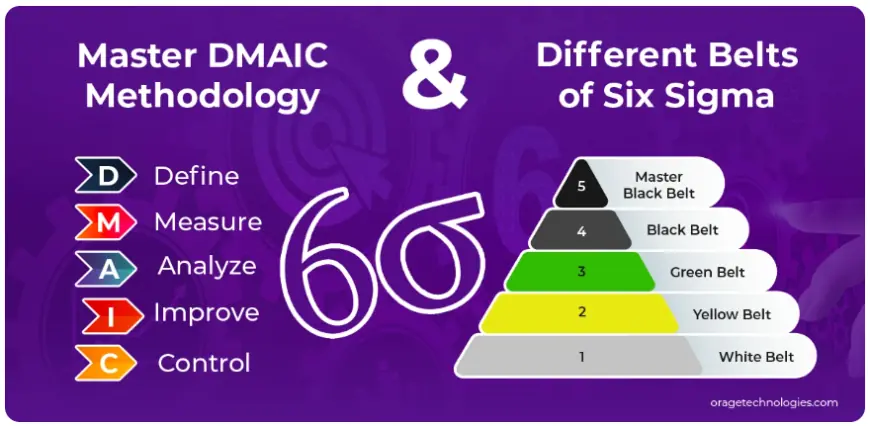Understanding DMAIC and the Six Sigma Belt System
Six Sigma is a data-driven methodology in which a variety of business processes is improved, errors are minimized, and quality is enhanced. The fundamental DMAIC framework and the hierarchy of Six Sigma belts are explained at Orage Technologies for the purpose of helping professionals work toward operational excellence and required efficiency across industries through structured problem-solving and continuous improvement methodology.

Discover DMAIC methodology and Six Sigma belt system in this detailed guide. Discover how they complement each other to improve processes, minimize waste, and raise standards for quality across industries. Ideal for professionals and organizations looking to succeed through data-driven methods.
With the hectic pace and competitiveness of business today, maintaining standards of excellence and minimizing waste is not only an aspiration as it's mandatory. Step in Six Sigma, a fact-based system for improvement of processes. Among its most widely used frameworks is DMAIC, a systematic guide to improving processes and resolving issues related to quality.
But Six Sigma is not only a process—it's also a network of certified experts that serve specific functions within project execution. The roles are designated based on a belt system such as in martial arts. In this blog entry, we'll discuss the DMAIC methodology and deconstruct the Six Sigma belt system to give you an idea of how this effective strategy can revitalize companies.
What Is DMAIC and Why Is It Important?
DMAIC is an acronym for Define, Measure, Analyze, Improve, and Control. It is a key tool in Six Sigma for process improvement by defining the problems, proposing solutions, and maintaining improvements over time.
Let's define the five steps:
1. Define – Explicitly define the problem, objectives, scope of the project, and the requirements of the customers.
2. Measure – Gather data to know current process performance and determine possible metrics.
3. Analyze – Analyze the data to identify root causes of defects or inefficiencies.
4. Improve – Apply and pilot solutions to the root causes.
5. Control – Check the process to maintain improvements and standardize them.
This step-by-step method guarantees that improvements are not only effectively implemented but also measurable and repeatable.
How Does DMAIC Fit Into Six Sigma?
Six Sigma is a more general philosophy aimed at reducing variation and defects in any process—manufacturing, service, healthcare, or even marketing. DMAIC is one of the basic problem-solving tools employed within Six Sigma to do just that.
The Six Sigma methodology is supported by statistical tools and project management best practices, and DMAIC is the framework for applying the tools. Without DMAIC, Six Sigma would have no systematic approach that makes it so predictable and consistent.
What Are the Roles Within the Six Sigma Belt System?
Like martial arts, Six Sigma classifies skill and responsibility by belt color. Here's a breakdown:
1. White Belt
* Who it's for: New team members or beginners in Six Sigma.
* Responsibilities: Familiarize themselves with elementary Six Sigma concepts and assist project teams on the local level.
* Training: Limited or initial-level training.
2. Yellow Belt
* Who it's for: Employees involved in smaller project roles.
* Responsibilities: Familiarize themselves with basic DMAIC fundamentals and contribute to data analysis and collection.
* Training: Often includes a couple of days of classroom training or online modules.
3. Green Belt
* Who it's for: Mid-level professionals and team leaders.
* Responsibilities: Participate in small-scale projects through the application of DMAIC under the supervision of Black Belts.
* Training: More thorough, with hands-on use of tools such as process mapping, fishbone diagrams, and control charts.
4. Black Belt
* Who it's for: Project managers and senior professionals.
* Responsibilities: Develop full-scale Six Sigma projects and sponsor Green Belts.
* Training: Mastering DMAIC, statistics, project management, and leadership.
5. Master Black Belt
* Who it's for: Strategic leaders and experts.
* Responsibilities: Mentor and train Black and Green Belts, ensure Six Sigma projects are aligned with business objectives.
* Training: Highly advanced and in many cases requires successful completion of multiple Six Sigma projects.
6. Champion
* Who it's for: Executive sponsors.
* Responsibilities: Fund, resource, and align with organizational priorities.
* Training: Executive summary instead of technical certification.
How Does One Choose the Right Belt?
Your experience, line of work, and the degree of participation you wish to have in process improvement projects determine the suitable Six Sigma belt to choose.
* If you're beginning or seeking foundational knowledge, White or Yellow Belt could be the best.
* To lead little projects or assist in bigger ones, a Green Belt is a suitable second step.
* For complete project leadership or as a consultant, a Black Belt is necessary.
* For becoming a strategic process improvement leader, opt for a Master Black Belt.
Begin with your objectives and present role to choose the most applicable belt certification.
You can also check it out: https://oragetechnologies.com/six-sigma/
What Are the Benefits of Using DMAIC and Six Sigma?
DMAIC and the Six Sigma belt system present several advantages to individuals and companies:
* Increased Process Efficiency: Streamline processes and eliminate waste.
* Increased Quality: Minimize defects and provide improved customer satisfaction.
* Cost Reduction: Eliminate unnecessary costs through data-driven decisions.
* Career Advancement: Certified experts are highly sought after in various industries.
* Scalability: DMAIC can be used on small or big projects in any area.
A combination of the methodology (DMAIC) and organization structure (belt system) makes for an effective change and continuous improvement engine.
Frequently Asked Questions
-
Is DMAIC Only Used in Manufacturing?
No, DMAIC can be used in any industry such as healthcare, IT, finance, logistics, and even marketing. Any process which can be measured and optimized can be improved with DMAIC.
-
How Long Does it Take to Get a Six Sigma Certification?
* Yellow Belt: A few days
* Green Belt: 2-4 weeks (part-time)
* Black Belt: 1-3 months (part-time or full-time)
* Master Black Belt: 6 months to a year
The duration will vary based on the certifying organization and your availability.
-
Do I Need to Be Mathematically Inclined to Learn Six Sigma?
Whereas Six Sigma does involve statistics, most DMAIC tools that are used (particularly for Yellow and Green Belts) are available to non-technical staff. More advanced belts may expect some familiarity with data analysis, but training courses typically provide all the maths you'll need.
-
Can I Use DMAIC Without Certification?
Yes. DMAIC is a process that can be learned and used by anyone, but having certification adds credibility and formalism to your knowledge.
Conclusion
The DMAIC framework and the Six Sigma belt system provide an organized, repeatable method of addressing real-world business issues. You're an executive who wants to drive profitability, a professional who needs a career boost, or a business leader that wants operation excellence; learning DMAIC and the Six Sigma hierarchy is a solid step in the right direction.
By learning the tools and positions of these, you not only enhance your productivity and analytical capabilities but also play a vital role in your organization's success.
What's Your Reaction?
 Like
0
Like
0
 Dislike
0
Dislike
0
 Love
0
Love
0
 Funny
0
Funny
0
 Angry
0
Angry
0
 Sad
0
Sad
0
 Wow
0
Wow
0


















































